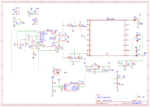Dimitrisvlamis
Member level 2
Hello everyone 
I am currently working in this SMPS which works perfect except the regulation part. I found a schematic on the internet that is almost idetical to mine but the voltage is not 380VDC but 220VDC. The circuit is this and it works as far as i know!
The problem i have is i need to regulate the voltage to 380V and i used 3 diodes of 1.3W each 2 180V And 1 20V to achieve that, with the same optocoupler. My schematic is this :
How can i calculate the correct resistor value? I have a big margin in voltage, it goes from 400v @10v input and goes till 600V at 15-16V input. Can someone help me with this? Maybe i use small zeners? Maybe a wrong optocoupler?
Thanks in advance
I am currently working in this SMPS which works perfect except the regulation part. I found a schematic on the internet that is almost idetical to mine but the voltage is not 380VDC but 220VDC. The circuit is this and it works as far as i know!

The problem i have is i need to regulate the voltage to 380V and i used 3 diodes of 1.3W each 2 180V And 1 20V to achieve that, with the same optocoupler. My schematic is this :

How can i calculate the correct resistor value? I have a big margin in voltage, it goes from 400v @10v input and goes till 600V at 15-16V input. Can someone help me with this? Maybe i use small zeners? Maybe a wrong optocoupler?
Thanks in advance

